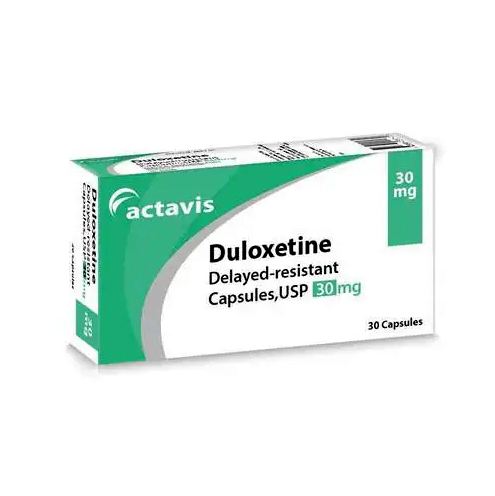Duloxetine hydrochloride is indicated for the treatment of depression. Duloxetine dosage is effective in maintaining clinical improvement during continuous treatment for up to six months in patients who have responded to the initial treatment. Duloxetine hydrochloride (active substance) is indicated for the treatment of:
- Major depressive disorder.
- Diabetic peripheral neuropathic pain.
- Fibromyalgia (FM) in patients with or without major depressive disorder (MDD).
- Chronic pain states associated with chronic low back pain.
- Conditions of chronic pain associated to knee osteoarthritis in patients over 40 years and – generalized anxiety disorder.
What side effects does Duloxetine have?
Like other serotonin and noradrenaline reuptake inhibitor drugs, duloxetine dosage has a lot of side effects. However, not all are serious and are more bearable than those caused by other antidepressants. In addition, these are significantly reduced if consumed accompanied by food. Unwanted side effects can be divided into serious and not serious. In the former, the patient should contact their doctor if they become more severe or lengthen in time, while in the latter they should inform immediately.
Not serious side effects
The side effects of duloxetine that are considered to be minor are the following.
Gastric problems – during continuous use of this substance you can experienced several gastric problems. Even form of digestive acids in excessive format.
Vomiting – this is another side effect. It may occur during the night sleep. It also comes under withdrawal symptoms.
Lack of appetite – often during the side effect you may experience lack of appetite. You can feel dry mouth and, you consume less food.
Dry mouth – during lack of appetite you feel weaker. Your body consumes more water but, you still feel dry mouth and, sometimes sores inner wall.
Problems in urination – your urine colour may turn to pale yellow. There may be not be an itchy feeling but, you have to go to the toilet for several times in a day.
Headaches – You feel headache while sleeping at night. It does not go away unless you take the medication again.
Pain and / or muscle spasms – There may be mild body aches or, muscle pain. Often you feel joint pain during the second week of side effects.
Serious side effects
Duloxetine is produced in delayed-release capsules to be taken orally. This means the active ingredients are not released until they reach the intestine and thus bypass stomach gastric acids. The treatment will start gradually, initially administering a low dose which will be increased once a week. This psychotropic drug also has other side effects of greater severity. They are the following.
Skin disorders and itching – This is one of the most serious side effects of this drug. You can experience different skin disorders such as patchy skin, black spots, burning sensation on skin, big rashes, red skins (allergic), dry skin, sores and open pores etc. There may be itchy sensation beneath the skin. It weaken the skin tissues.
Bleeding and / or bruising without apparent cause – There will be a chance to bleed. Often medical practitioner have recorded several bleeding cases that happened due to the side effects of this drug, without any reasons. There may be red spot (due to blood clot) in your skin or, under the eyes. In most of the cases, patient bleeds from their nose.
Inflammation of the abdomen – During the excessive over dose or, chronic side effects and, long term use, this drug can damage your liver. It accelerates the amounts of gastric acids. It causes the burning sensation in the abdominal tube. Long term inflammation can cause severe liver damage and, it can also cause of ulcers.

Yellow eye colour – One of the most important side effects. The eyes turn into pale yellow colour. You can feel that your eyes are dried. This long term side effect can cause harm to your retina and, sometimes it is responsible for blood clot in your eyes.
Confusion – This drug makes your thinking process go slow. You cannot think fast. There are so many confusions in your mind. This happens due to extreme dosage of this drug as it blocks the neurotransmitter or, slower the brain function. You start feeling mild headache and, often forget what to do.
Most common side effects at a glance
Although, there are several other major issues that happens due to this drug – Cymbalta Duloxetine. They are: problems in vision, fever, flu symptoms, blisters, rash and / or urticarial, and, problems in breathing and swallowing. If you see common duloxetine reviews, you can understand how this drug can be helpful and, how it gives you side effects if use for a long time.
Possible side effects
The most common side effects or, duloxetine withdrawal that may occur during treatment with Duloxetine are dry mouth, nausea, and headache. Also palpitations, tinnitus, blurred vision, constipation, diarrhoea, vomiting, poor digestion, abdominal pain, excessive gas, fatigue, decreased appetite and weight, hypertension, muscle spasms and stiffness, musculoskeletal pain, dizziness, sleepiness, tremor, paraesthesia, insomnia, decreased sexual desire, anxiety, restlessness, abnormal dreams, altered urinary frequency, ejaculation disorder, erectile dysfunction, hyperhidrosis, night sweats, itching, and flushing.
Side effects due to overdose
In order to prevent prolonged side effects from getting worse, take duloxetine exactly as prescribed. Do not modify the dose of duloxetine. If you forget to take a dose of duloxetine, take the missed dose as soon as you remember. If your next scheduled dose is within a four-hour time frame, do not take the missed dose and take only the regular dose. Never duplicate this medication, as this can cause duloxetine overdose. Side effects of an overdose include tachycardia, nausea, vomiting, light headedness, mild confusion, or diarrhoea. Seek medical attention if you experience any side effect resulting from an overdose of duloxetine.
Severe long-term side effects
Some of the side effects associated with duloxetine require emergency medical attention. Do not wait for these serious side effects to go away, as they can be life-threatening. If you are experiencing a yellowing of the skin, nausea, and are having difficulty urinating and are discoloured, seek emergency care. Duloxetine is also associated with bloody stools, severe stomach upset, and difficulty breathing. Exceptionally sore or stiff muscles are also a potential side effect of duloxetine, and may last for prolonged periods of time. Do not wait for the symptoms to stop, seek immediate medical attention, as your condition may worsen.
Moderate side effects
Duloxetine is also associated with less severe side effects that may persist for a few days. Some duloxetine withdrawal may last as long as you continue taking duloxetine, and possibly for weeks after stopping treatment. Side effects that may be prolonged include dizziness, drowsiness, constipation, gas or bloating, blurred vision or dry mouth. Duloxetine is also associated with weight fluctuations, insomnia (both gain and loss), decreased sexual interest and impotence. Sexual side effects may persist for weeks, after treatment with duloxetine has been discontinued.
For What Disorders is Duloxetine Used?
The disorders and conditions in which an antidepressant such as duloxetine is administered are varied and, range from psychological disorders such as major depression and generalized anxiety disorder, even physical illnesses such as pain caused by peripheral neuropathic conditions, chronic low back pain, osteoarthritis or fibromyalgia.
Major depressive disorder
The suggestive dose for starting is 60 mg, for one time every day. In some cases, treatment with the 30 mg dose may be started once a day for one week to allow the person to adjust to the drug before increasing to 60 mg.
Diabetic peripheral neuropathic pain
Treatment should be started at a dose of 60 mg once daily, however, for patients whose tolerability is a concern, it may be considered a lower dose.
Fibromyalgia
Treatment should be started at a dose of 60 mg once daily. In some cases, it may be necessary to start treatment with the 30 mg dose once a day for one week. In order for the person to adjust to the amount before consuming 60 mg higher dose.
Chronic low back pain or knee osteoarthritis
Treatment should be started at a dose of 60 mg once daily. However, in some cases it may be necessary to start treatment at a dose of 30 mg per day for one week to facilitate adaptation to the drug, before increasing the dose.
Who Should Not Use Duloxetine?
Duloxetine should not be used by people with known hypersensitivity or, any of its excipients, nor should it be given concurrently with monoamine oxidase inhibitors. In addition, it should also not be used by pregnant or breastfeeding women. The dosage must be determined by the doctor and depends on the treatment that is intended to be performed.
Conclusion
In addition, it is also prescribed at the beginning of stress urinary incontinence. This type of incontinence is one in which the person suffers some escape urine while doing physical activities or effort. They can also appear when coughing, lifting a heavy object or making some physical effort. In any case, the use of this drug can only be given by medical indication, and it is also essential to follow exactly the indications given by the professional.









